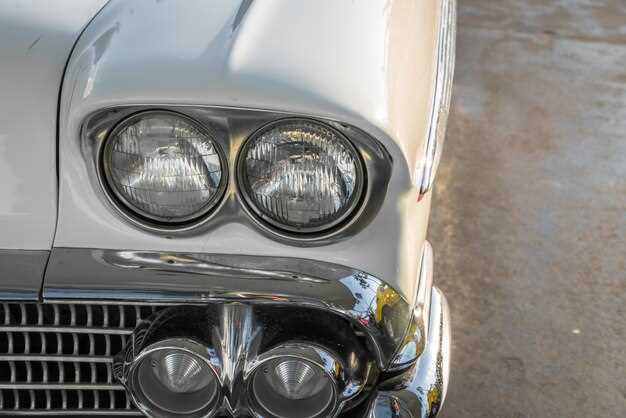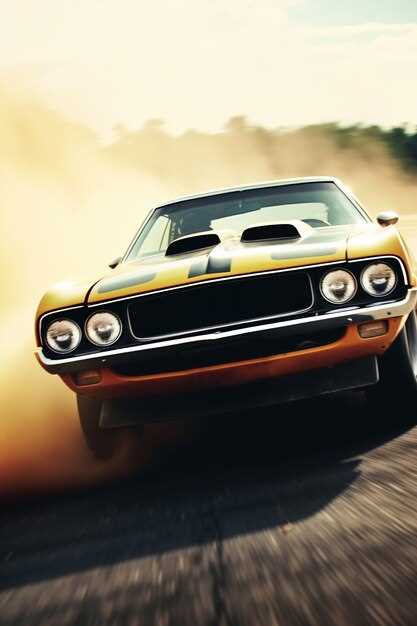For serious collectors, the allure of classic muscle cars is undeniable. Their raw power and distinctive style make them a prized possession. Begin with the 1969 Ford Mustang Mach 1. This legendary model combines unmistakable design with a robust V8 engine, offering performance that still impresses today. Its sleek lines and aggressive stance capture the essence of American muscle.
Next on the list is the Chevrolet Camaro SS, particularly the 1969 version. This car stands out with its powerful 396 cubic inch engine, which promises thrilling acceleration. The iconic split front grille and long hood add to its desirability among collectors.
Don’t overlook the Dodge Charger R/T from 1970, a true embodiment of power and speed. With its high-performance HEMI engine option, it delivers an exhilarating driving experience. The bold design and spacious interior enhance its appeal, making it a top pick for enthusiasts.
Each of these classics offers unique characteristics that define muscle car culture. Paying attention to their specifications and historical significance can help any collector build an impressive garage. Investing in these iconic vehicles will certainly bring joy for years to come.
Understanding the Muscle Car Phenomenon in America
Muscle cars symbolize American automotive culture, showcasing power, speed, and style. Iconic models like the Ford Mustang, Chevrolet Camaro, and Dodge Charger emerged in the 1960s, appealing directly to a demographic eager for affordable performance vehicles. These cars, equipped with robust V8 engines, ignited a passion for horsepower.
The allure of muscle cars lies in their performance capabilities. For instance, the 1968 Chevy Camaro SS could accelerate from 0 to 60 mph in just over 6 seconds. This rapid speed, along with dynamic styling, created an exciting driving experience that resonated with enthusiasts.
Customization and personalization remain key aspects of the muscle car culture. Collectors often modify engines, exhaust systems, and aesthetics to create unique vehicles that reflect their personalities. This hands-on approach fosters community among builders and collectors, inspiring participation in shows and races.
The historical context adds depth to the muscle car phenomenon. During the 1960s and 1970s, muscle cars emerged as a response to the American desire for freedom and rebellion, mirroring societal shifts of the time. Films like “Bullitt” and “American Graffiti” further cemented their status, presenting these vehicles as symbols of youth and adventure.
Today, muscle cars continue to evolve, blending classic elements with modern technology. Newer models like the Ford Mustang Mach-E showcase electric capabilities while retaining the spirit of performance. Collectors appreciate both traditional and contemporary vehicles, recognizing their significance in automotive history.
Engaging with muscle cars can be more than a hobby; it becomes a lifestyle. Join clubs, attend shows, and participate in races to fully immerse yourself in this exhilarating world. The sense of camaraderie among enthusiasts enhances the experience, creating lasting friendships centered around a shared passion for powerful performance. Collecting muscle cars is not just about owning a vehicle; it’s about preserving an irreplaceable piece of American culture.
Identifying Iconic Models and Their Unique Features
Chevrolet Camaro stands out with its muscular stance and aggressive styling, particularly the 1969 model, featuring classic split headlights and a variety of powerful V8 engine options. Its sporty design and performance make it a staple in muscle car collections.
Ford Mustang, especially the 1967 Fastback, is revered for its blend of style and speed. The fastback profile and the option for high-performance engines, such as the 390 V8, showcase its racing pedigree. Collectors appreciate its cultural significance as well as its performance features.
Next is the Dodge Charger, notably the 1970 model, recognized for its sleek lines and iconic Coke bottle shape. Its broad hood and aggressive front grille house high-performance engines that deliver impressive horsepower, making it an appealing choice for enthusiasts.
| Model | Year | Unique Features |
|---|---|---|
| Chevrolet Camaro | 1969 | Split headlights, V8 options, sporty design |
| Ford Mustang | 1967 | Fastback profile, racing engines, cultural significance |
| Dodge Charger | 1970 | Coke bottle shape, aggressive grille, high horsepower |
Plymouth Barracuda, particularly the 1970 model, is celebrated for its distinctive styling and performance. Its use of the potent 426 HEMI engine in some trims adds to its allure among collectors.
Lastly, the Pontiac GTO, the 1966 version showcases bold lines and a robust engine lineup, epitomizing the original muscle car era. Its reputation for performance, coupled with its attractive design, makes it a must-have for any serious collector.
Evaluating Market Trends and Investment Potential
Focus on specific models that consistently appreciate in value, such as the Ford Mustang, Chevrolet Camaro, and Dodge Charger. Analyze auction results and sales data from reputable sources like Barrett-Jackson and Mecum Auctions. These platforms provide insights into price fluctuations and buyer preferences.
Check online marketplaces frequently for price trends. Websites like Hemmings and Bring a Trailer can help identify which muscle cars are gaining popularity. Pay attention to condition, originality, and rarity; these factors significantly influence market value. Models with low production numbers often see greater demand.
Engage with local car clubs and collector communities. Networking with other enthusiasts can reveal upcoming trends or shifts in interest. Members often share information about potential investments or restoration projects worth pursuing. Participate in car shows to observe which models attract attention and generate buzz among collectors.
Consider the history and lineage of specific models. Cars with a racing pedigree or notable historical significance frequently command higher prices. Researching the background of each car can provide insights into future appreciation potential.
Monitor economic indicators that affect disposable income and luxury spending. A strong economy typically boosts the classic car market, while economic downturns can lead to decreased demand. Stay informed on broader market conditions to make timely investment decisions.
Finally, always assess your personal interest in a car. Authentic passion for the vehicle will enhance your enjoyment and commitment to ownership. This blend of personal engagement and strategic investment maximizes both satisfaction and potential return.
Decoding VINs and Documentation for Authenticity
Decode the Vehicle Identification Number (VIN) by locating the 17-character code typically found on the dashboard near the windshield or inside the driver’s door frame. Each character in the VIN carries specific information about the car’s manufacturer, model, year, and assembly location. For muscle cars, pay special attention to the 10th character, which indicates the model year. For example, ‘67’ represents 1967, a key year for many classic muscle cars.
Comparing the VIN to the documentation is vital. Verify the matching VIN on the title, registration, and any service records. Inspect any discrepancies, as mismatches may indicate alterations or, in some cases, fraud. Look for original documents, including the owner’s manual, and factory build sheets. Authentic build sheets provide invaluable insights into original factory specifications and options, giving you more confidence in the car’s history.
Additionally, check for the presence of an original title. Titles from the car’s first ownership can enhance value and authenticity. Research the car’s history through sources like Carfax or AutoCheck. These reports can reveal previous accidents, ownership changes, and service history, ensuring you have a complete view of the vehicle’s past.
Joining forums dedicated to classic muscle cars can also offer insights. Engage with other collectors who can share experiences and information about verifying authenticity. They can provide tips on examining specific features typical to various models, enhancing your understanding of the car you are interested in.
Documentation and VIN decoding are crucial in confirming the authenticity of muscle cars. Take the time to thoroughly investigate these details, ensuring a wise investment and preservation of automotive history.
Essential Maintenance Tips for Classic Muscle Cars
Regular oil changes keep your engine clean and performing well. Use high-quality oil with the right viscosity for your car’s engine. Check and change oil filters simultaneously with every oil change.
Cooling systems can be tricky. Inspect the radiator and hoses for leaks, corrosion, or wear. Flush the coolant system every two years to prevent buildup. Always use the recommended coolant type for your vehicle.
Tires deserve close attention. Check tire pressure monthly and inspect for uneven wear or cracks. Rotate tires every 5,000 to 7,500 miles to promote even tread wear.
Brakes require careful monitoring. Listen for squeaking or grinding noises and check the brake fluid level regularly. Replace brake pads when they show signs of wear to ensure proper stopping power.
Battery maintenance is crucial. Clean battery terminals to reduce corrosion and check connections for tightness. Test the battery’s charge every six months, especially if your car is not driven frequently.
- Inspect belts and hoses every few months for cracks or fraying.
- Keep the interior and exterior clean to prevent corrosion and maintain value.
- Store your muscle car in a climate-controlled garage to protect against extreme temperatures and moisture.
Fuel systems need attention as well. Use fuel stabilizers when storing your muscle car for extended periods. Clean fuel injectors periodically to maintain performance.
Finally, consider an annual tune-up. Schedule a thorough inspection that covers ignition components, filters, and exhaust systems. Preventive care goes a long way in preserving the life of classic muscle cars.
Joining the Community: Clubs and Events for Collectors
Join a classic muscle car club to connect with fellow enthusiasts and gain valuable insights. Here are some popular clubs across the United States:
- Chevrolet Camaro Club: A great place for Camaro lovers to share tips, stories, and restoration projects.
- Pontiac Historical Society: Focuses on Pontiac vehicles, offering resources for restoration and historical information.
- Mustang Club of America: An established club providing access to events, shows, and a wealth of information about Mustangs.
- Mopar Muscle Club: Dedicated to Chrysler products, this club offers gatherings, meetups, and technical assistance.
Participating in local events increases your network and enhances your knowledge. Look for:
- Car Shows: Check local event listings for classic car shows. These events attract collectors and provide opportunities to showcase your vehicle.
- Swap Meets: Great places to find parts, collect memorabilia, and meet like-minded collectors.
- Track Days: Experience the true power of muscle cars on the racetrack. Events often include timed runs and amateur racing.
- Annual Rallies: Groups often organize rallies that allow collectors to drive their cars together while enjoying scenic routes.
Don’t forget online forums and social media groups. Platforms like Facebook host numerous groups dedicated to classic muscle cars where you can connect with collectors nationwide, exchange ideas, and stay updated on events.
Engaging with the community opens doors to friendships and valuable knowledge. Attend meetings, participate actively, and share your passion for classic muscle cars.






